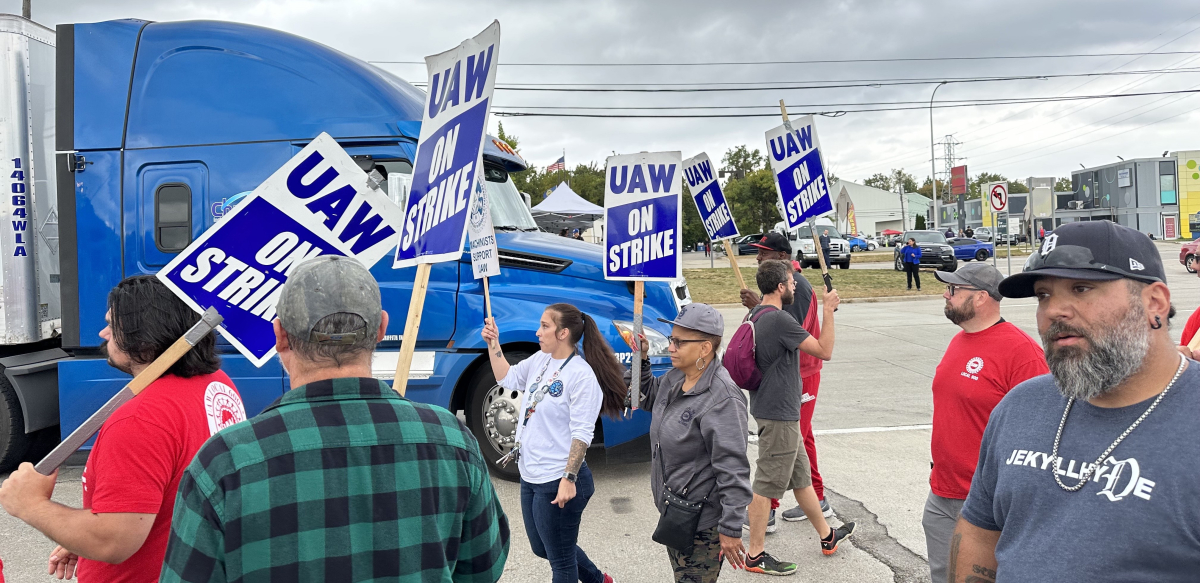‘Where There Are Scabs, There Is Violence’—That’s Why Scabs Are Illegal in Two Canadian Provinces

Striking UAW members picketed as a truck attempted to enter Ford's Michigan Assembly Plant in September. Photo: Luis Feliz Leon
Auto Workers President Shawn Fain has vigorously condemned violence on the picket lines in Michigan, Massachusetts, and California—laying the blame on management for using replacement workers, or as we usually call them in the labor movement, scabs.
But replacement workers are not a phenomenon we should take for granted. In Quebec and British Columbia, legislatures have adopted laws against the use of replacement workers.
SCABS BANNED SINCE 1977
The province of Quebec was the first jurisdiction in North America to pass legislation banning replacement workers, in 1977, after significant increases in picket line violence across the province. One dispute was a 20-month-long strike involving UAW Local 510 and United Aircraft (later called Pratt & Whitney), which became one of the most violent strikes in Canadian history. In a blunt observation about replacement workers, Quebec’s Minister of Labour, Pierre-Marc Johnson, stated on the floor of the legislature that “where there are scabs there is violence.” Johnson said his government further supported a greater balance in the bargaining dynamic between labor and management.
British Columbia’s progressive New Democratic Party government passed similar legislation in 1993. Both provinces provide very narrow exceptions to the ban, including the maintenance of “essential service” agreements (like paramedics) or the maintenance of vulnerable machinery.
Canada’s federal government considered a ban on replacement workers following the most tragic lockout experience since the UAW strikes in Quebec. The city of Yellowknife was torn between pro-union and pro-employer groups during the 18-month strike that began as a lockout in May 1992. Families who had worked the mine for generations were irreparably divided. Peggy Witte, the controversial CEO of Royal Oak Mines, employed Pinkerton guards whose primary purpose was to taunt picketers and flew in a police riot squad who fired warning shots above picketers’ heads. Canadian mining employers had rarely used scabs for 50 years; by bringing them in, Witte brought the collective bargaining to an end.
In response, the federal government adopted a ban on replacement workers—but only where it could be shown that the scabs were hired to undermine the union’s “representational capacity” rather than because the employer was pursuing “legitimate bargaining objectives.” Many advocates of the ban saw the federal response as lacking.
STRONGER BAN CONTEMPLATED
The federal Minister of Labour, Seamus O’Regan, recently announced his intention to propose legislation before the end of 2023 that would ban replacement workers, in the same way as Quebec and British Columbia, in the federal jurisdiction, such as transportation across provincial borders, communications, or "federal undertakings."
“We’re banning the use of replacement workers because we believe in collective bargaining,” O’Regan said. “Our economy depends on employers and workers staying at the table and reaching a deal. The use of replacement workers can distract from negotiations, it can prolong disputes, and it can poison labour relations for years after.”

SUPPORT LABOR NOTES
BECOME A MONTHLY DONOR
Give $10 a month or more and get our "Fight the Boss, Build the Union" T-shirt.
As O’Regan indicates, use of replacement workers undeniably shifts the balance of power. In both Quebec and British Columbia, maintaining the balance of power was a key motivating factor in enacting the bans.
Even in Canadian provinces where employers still have a right to use replacement workers, you will not find anything that resembles the right to make replacements permanent. This is a peculiarly American practice, dating back to the 1938 U.S. Supreme Court decision in MacKay Radio, when the Court put its thumb on the employer side of the scale. The policy conflict is glaring—if collective bargaining is encouraged and striking is legal, how can union workers lose their jobs by exercising their legal right to strike?
REAGAN SENT A SIGNAL
While the ability to use replacement workers dates back nearly a century in the U.S., it was seldom used by employers as a bargaining strategy. In 1981 President Ronald Reagan signaled a new era of anti-union strategies when he fired the striking PATCO air traffic controllers. This was a turning point for employer strike strategies. In the decade that followed, the use of replacement workers increased.
When scabs were used, strikes got longer—probably because it helps employers to hold out for longer. On average in the U.S., when no replacements were used, a strike would last 32 days. When replacement workers were hired the average duration increased to 70 days, and when replacements were permanent, to 217 days. Moreover, research found that with permanent replacements, 41 percent of bargaining unit members were replaced at the conclusion of the dispute. The same research found that approximately 30 percent of strikes include some form of violence; however, when replacement workers are involved, that violence rate rises to 46 percent and is more often characterized as serious.
The adoption of bans on permanent replacements in Canada has reduced the duration of strikes and eased picket line violence. Research by the then-federal department of Human Resources and Development Canada found that the introduction of these changes in Quebec reduced the average number of working days lost to strikes from 39 to 15. Likewise, the ban on replacements in 1993 in British Columbia lessened work stoppages by 50 percent. Both provinces continue to have robust economies.
Opponents of a ban on replacement workers express concern that it will result in richer contracts, and that unions will have too much power. The fact that Big 3 UAW members have not had meaningful improvements in working conditions over an extended period despite strong economic performance by their employers is evidence of the imbalance in the system. As Fain correctly observed, the world is watching.
Bill Cole has four decades of experience in collective bargaining, dispute resolution, and labor education in Canada. He is a Senior Research Associate at Harvard’s Center for Labor and a Just Economy.
